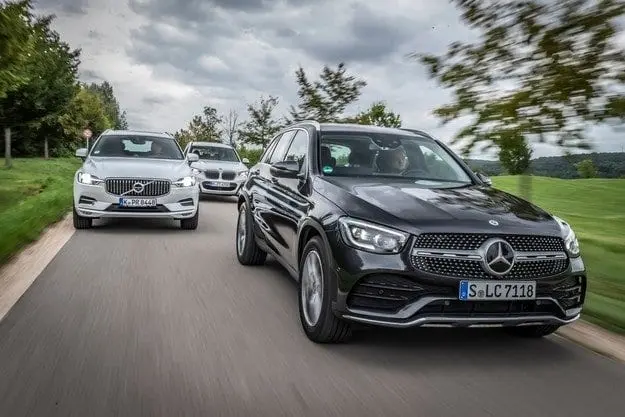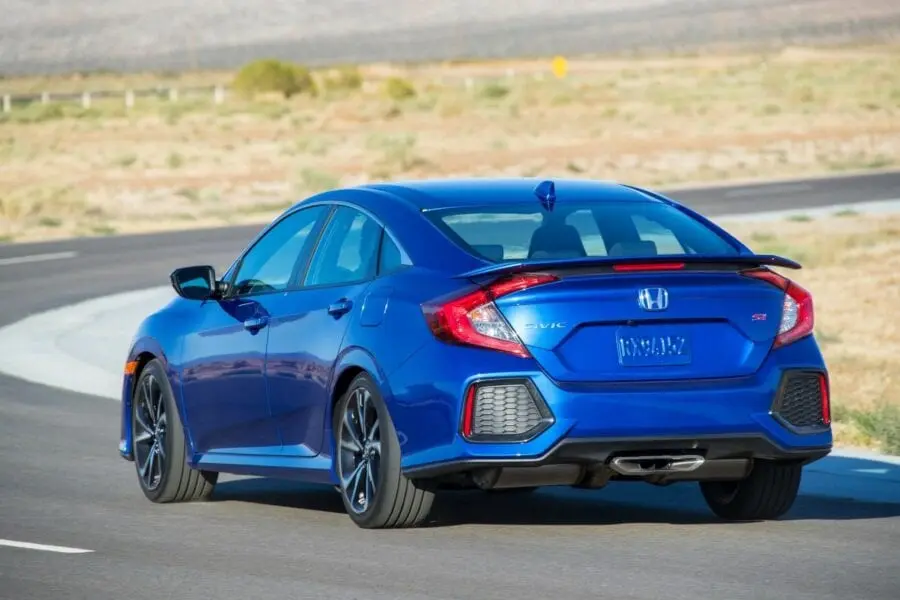
Test drive BMW X3, Mercedes GLC, Volvo XC60: Favorite characters

Competition between three highly popular SUVs from the upper middle class
In this comparative test, three extremely popular SUV models, equipped with powerful diesel engines of at least 245 hp, collide with each other. and 480 Nm. Updated recently The Mercedes GLC is up against the BMW X3 and Volvo XC60, the latest model with mild hybrid technology and a small electric motor.
From the very beginning of this article, we want to make a compliment. Praise for the fact that Volvo launched its hybrid models quite early on. And also the fact that the Swedish manufacturer with Chinese owners left the corner of the archaic traditionalists and has since created style symbols such as the XC60.
In recent years, the brand's cars have become so sophisticated that their membership in the elite models club is undeniable.
This time, the XC60 will face the BMW X3 and the recently redesigned Mercedes GLC. In particular, we compare powerful diesel models. The XC60 B5 AWD Mildhybrid develops 249 hp. and 480 Nm, which come from a four-cylinder biturbo engine and a small electric motor (the latter with 14 hp and 40 Nm). The GLC 300 d 4Matic is a 245 hp four-cylinder unit. and 500 Nm. The comparable X3 xDrive 30d is powered by a gorgeous 265-liter inline-six with 620 hp. and XNUMX Nm.
The M Sport version of the BMW X3 costs from 125 levs, Mercedes with the AMG Line package – from ??? ??? The starting price of Volvo in the Inscription modification is 400 leva. But make no mistake - despite their high prices, all three cars should come equipped with a lot of stuff like metallic paint, big leather-wrapped wheels and infotainment features. To the delight of manufacturers, such equipment usually costs from 115 euros.
Volvo XC60
The XC60 exudes a cool technocratic flair and, combined with the options ordered for the test car, looks quite refined indeed. The workmanship is excellent, but we can't say the same for the ergonomics, which are almost entirely controlled via the touchscreen. Navigating menus takes a lot of time and attention and is very distracting while driving. This is inconvenient and often dangerous. Otherwise, in terms of interior space, the model is better than its predecessor, and still falls slightly behind its two rivals. It's a little strange to find that the Swedes seem to have forgotten their golden tradition in terms of practical station wagons - if you're looking for things like remote unlocking of the rear seats or splitting the three rear seats in the XC60, you'll only have to search. Otherwise, the fact is that the rear seats offer unusually good lateral support for this class, and the front seat is even more comfortable, albeit a little too high.
Weighing more than two tons, we are pleasantly surprised by the agility: Volvo is easy and pleasant to drive, albeit with one caveat: when the front wheels start to lose traction, you suddenly find that the lightness of the steering wheel is entirely due to feedback. ... And since the rear axle is connected to the drive only by a plate clutch, this also does not help much in stabilizing the car in such situations. The optional air suspension has an almost imperceptible effect on vehicle behavior. By an almost imperceptible effect, we mean that the air suspension can hardly change the effect of the presence of 20-inch wheels, and they are very hard to pass through bumps, sometimes even causing the body to squeak. No, it cannot be called a feeling of the upper class. Since practicality is in our blood, we recommend that you simply and simply order a car with smaller wheels and higher bead tires. And with standard suspension. It will ride better and be cheaper for you. However, with this mindset at the Inscription equipment level, the minimum wheel size is 19 inches. In any case, given that shoppers are buying widely, it is clear that reason has not been one of the most basic buying criteria lately.
By the way, the effect of mild hybrid technology is also quite modest. The extra battery doesn't help the XC60 spend a lot of time or be particularly dynamic. The expected plus in terms of acceleration from a standstill is not noticeable - the car has a decent, but not sporty temperament. Otherwise, it is a fact that with 8,2 liters per 100 kilometers it is slightly more economical than its opponents. But the difference is so small that it does not bring him points. Finally, the XC60 remains last in the rankings.
BMW X3
Like Volvo, we want BMW to start with praise. Because the interior of the X3 is finally at the height of its image. Not that we still haven't found some good budget details, but we won't overdo it. It is also a fact that the workmanship and ergonomics are excellent: the iDrive system has an optimal balance between rich functionality and really good and easy-to-use control logic.
The high payload is one of the signs that BMW is serious about the functionality of its models in this category. When folding backrests with a remote backrest, a small threshold is obtained at the bottom of the cargo compartment, but this does not detract from the practical qualities of the model. The double-bottom trunk and grab rails are also handy solutions, only the rear seats could be a little softer upholstered. At the front, we're a little lacking in the ability to adjust the seats one idea lower, so that their position is optimal in terms of driving pleasure.
Unfortunately, we have to mention that the X3 is only partly fun to drive, because the car's size and weight don't exactly match the high center of gravity very nicely. In principle, rear-wheel drive oriented to the rear axle should help in this direction, it is expected that 20-inch wheels with size 275 rollers on the rear axle, M-Sport equipment with a sports brake system and variable steering will also contribute to this goal. . more dynamic behavior - but only partial success. The massive 4,71-meter SUV passed the fastest of the three models in the test through driving exercises, but to call it an extremely enjoyable driving experience would be an overstatement. In fact, the not-so-communicative steering is disappointing.
While the Bavarian SUV is equipped with optional adaptive dampers and is undeniably better than the Volvo at absorbing short bumps, the BMW is prone to some pretty nasty bumps in undulating bumps. It is impossible not to notice that the X3 has the longest stopping distance of a hundred kilometers - and with the addition of a sports brake system. So investing in this attractive-sounding option does not bring the expected result. On the other hand, BMW achieves impressive results in terms of multimedia equipment.
What about overclocking? The X3 30d delivered the highest torque in this test. And as expected, it accelerates the fastest from zero to one hundred kilometers per hour. Its inline-six is also superb, no doubt about it. Despite the highest fuel consumption (8,5 l / 100 km), BMW easily outperforms Volvo in terms of powertrain and in all other categories, with the exception of environmental friendliness and cost. It remains to be seen how Mercedes will perform.
Mercedes GLC
In the GLC, technological upgrades are much more important than stylistic retouching. The all-new four-cylinder diesel engine is the only one in the test that meets Euro 2021d standards, which will only come into effect in 6. It is even more pleasing to find that the sophisticated cleaning technology has not adversely affected the dynamics of the car, on the contrary - subjectively, the 300 d seems extremely agile. The responses from the turbochargers and automatic transmission are excellent, and we're particularly pleased that Mercedes has avoided the annoying tendency to downshift hyperactively by making full use of the high torque. That objective measurements do not fully cover the sensations described should not surprise you; the subjective does not always coincide with the objective.
The fact that the engine is significantly quieter than its predecessor is clear from the noise measurements – at 80 km/h, when aerodynamic noise is not yet important, the model is the quietest in the test. It's a direct transition to the traditional top discipline for Mercedes: the optional air suspension certainly offers the best ride in the current comparison. The slight hurdle is only 19-inch wheels, which brings us back to the already mentioned wheel sizing issue - if it wasn't for the AMG Line version, the GLC 300 d could have stepped on much more comfortable 17-inch wheels. .
Mercedes, by the way, allows itself the luxury of providing its customers with the opportunity for truly serious off-road, which distinguishes it from BMW and Volvo models. All the more interesting is that on the pavement, the GLC manages to beat its rivals, and from a long distance: it sounds unexpected, but Mercedes boasts the most sporty ride. The steering and suspension provide the best feedback in this test, and the ride over bumps is the smoothest. The high seating position may not be to everyone's taste, but it provides excellent visibility in all directions. Excellent brake test results go hand in hand with extensive safety equipment and a host of assistance systems.
The MBUX system in the GLC boasts a good voice control feature. Surprisingly, Mercedes is not the most expensive car in the test, although one cannot help but notice that it has the poorest equipment. In addition, his fuel consumption is quite decent - 8,3 liters per kilometer.
Mission accomplished, it's time for the final kudos in this test, and it's up to Mercedes: the facelifted GLC 300 d enters the second phase of model life in a convincing manner - with an absolutely deserved win in this comparative test.
CONCLUSION
1. MERCEDES
The GLC chassis remarkably combines the best comfort and the most dynamic driving behavior in this test. In addition, the model has excellent brakes and excellent handling.
2. BMW
The magnificent inline-six brings the X3 a definite and well-deserved victory in the power section, but otherwise lags behind the winner a bit.
3. VOLVO
The HS60 is neither a leader in safety nor in comfort. Otherwise, the mild hybrid shows a slight advantage in fuel consumption.
Text: Markus Peters
Photo: Dino Eisele

